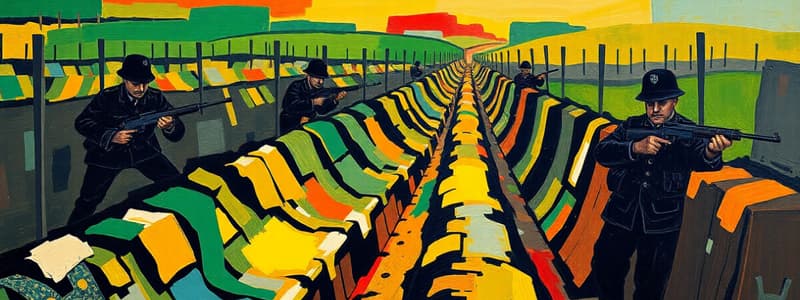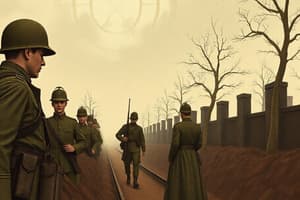Podcast
Questions and Answers
What was a major consequence of the stalemate caused by trench warfare during World War I?
What was a major consequence of the stalemate caused by trench warfare during World War I?
- Increased mobility of armies
- Immediate peace negotiations
- Quick territorial gains for both sides
- A prolonged conflict with high human costs (correct)
Which of the following best describes 'No Man's Land'?
Which of the following best describes 'No Man's Land'?
- The safe zone for medical personnel
- The area predominantly occupied by artillery
- A dangerous territory between opposing trenches (correct)
- The fortified region behind enemy lines
What percentage of casualties during WWI was attributed to artillery?
What percentage of casualties during WWI was attributed to artillery?
- 70% (correct)
- 90%
- 50%
- 30%
What was a common health issue faced by soldiers in the trenches?
What was a common health issue faced by soldiers in the trenches?
Which chemical weapon was first used by the German Army in 1915?
Which chemical weapon was first used by the German Army in 1915?
What was the primary driving factor behind the militarism that led to World War I?
What was the primary driving factor behind the militarism that led to World War I?
What condition could result from prolonged exposure to wet conditions in the trenches?
What condition could result from prolonged exposure to wet conditions in the trenches?
What described the living conditions for soldiers in the trenches during World War I?
What described the living conditions for soldiers in the trenches during World War I?
What was the political purpose of the Black Hand in the lead-up to World War I?
What was the political purpose of the Black Hand in the lead-up to World War I?
How did nationalism contribute to the tensions in Europe prior to World War I?
How did nationalism contribute to the tensions in Europe prior to World War I?
What was one immediate effect of the assassination of Archduke Franz Ferdinand?
What was one immediate effect of the assassination of Archduke Franz Ferdinand?
What were the main components of the alliances in Europe prior to World War I?
What were the main components of the alliances in Europe prior to World War I?
What was a defining characteristic of imperialism leading up to World War I?
What was a defining characteristic of imperialism leading up to World War I?
Which coalition fought against the Central Powers during World War I?
Which coalition fought against the Central Powers during World War I?
What is the 'Domino Effect' in the context of World War I?
What is the 'Domino Effect' in the context of World War I?
Which of the following best describes the scale of World War I?
Which of the following best describes the scale of World War I?
Flashcards
Trench Warfare
Trench Warfare
A type of warfare involving fortified trenches, primarily used in WWI. Both sides dug trenches, creating a stalemate.
No Man's Land
No Man's Land
The area between opposing trenches, a dangerous space heavily contested during attacks.
Stalemate
Stalemate
A deadlock in warfare where neither side achieves a clear victory, resulting in prolonged conflict.
Artillery
Artillery
Signup and view all the flashcards
Poison Gas
Poison Gas
Signup and view all the flashcards
Dysentery
Dysentery
Signup and view all the flashcards
Trench Foot
Trench Foot
Signup and view all the flashcards
World War I
World War I
Signup and view all the flashcards
Militarism
Militarism
Signup and view all the flashcards
Alliances
Alliances
Signup and view all the flashcards
Nationalism
Nationalism
Signup and view all the flashcards
Imperialism
Imperialism
Signup and view all the flashcards
Assassination of Archduke Franz Ferdinand
Assassination of Archduke Franz Ferdinand
Signup and view all the flashcards
Central Powers
Central Powers
Signup and view all the flashcards
Allied Powers
Allied Powers
Signup and view all the flashcards
Study Notes
Trench Warfare
- Trench warfare involves extensive, fortified trenches for combat, primarily used during World War I.
- This method offered protection against machine gun fire but created a stalemate on the Western Front.
- Stalemate refers to a deadlock in warfare where neither side achieves a critical victory, resulting in prolonged conflict.
- No Man's Land is the treacherous area between opposing trenches, averaging 225 yards wide, heavily contested during attacks.
- Artillery was crucial in WWI, causing 70% of casualties; barrages involved thousands of guns firing millions of shells to breach defenses.
- Poison gas, first used by Germany in 1915, including chlorine and mustard gas, instilled fear and caused substantial casualties.
- Conditions in the trenches included severe hardships, with health issues like dysentery, trench foot, and infestations of rats and lice.
- Dysentery resulted from unsanitary conditions, leading to dehydration and potential fatalities.
- Rats thrived on discarded food and decomposing bodies, exacerbating poor sanitary conditions and disease spread.
- Trench foot developed from prolonged wet conditions, risking severe complications like gangrene.
Key Concepts Analysis
- World War I spanned from July 28, 1914, to November 11, 1918, resulting in nearly 8 million deaths and 22 million wounded.
- Militarism emphasizes building strong military forces, seen in the arms race that escalated tensions leading to the war.
- Alliances, formal agreements for mutual support, led to a polarized Europe with the Triple Alliance (Germany, Austria-Hungary, Italy) and the Triple Entente (France, Russia, Great Britain).
- Nationalism fueled pride and desires for self-determination, increasing tensions, particularly in the Balkans.
- Imperialism involved extending a nation's power through colonization, creating rivalries, especially between Britain and Germany.
- The assassination of Archduke Franz Ferdinand on June 28, 1914, by a Serbian nationalist sparked the war's outbreak.
- The Black Hand, a Serbian nationalist group, aimed for a Greater Serbia, playing a critical role in the assassination.
- The Domino Effect refers to the chain reaction of events initiated by the assassination, leading to declarations of war among allies.
- Central Powers included Germany, Austria-Hungary, the Ottoman Empire, and Bulgaria.
- Allied Powers consisted of Russia, France, Great Britain, Italy, Japan, and later the United States.
Overview of World War I
- World War I began on July 28, 1914, and ended on November 11, 1918.
- Recognized as the "First World War" due to its unprecedented global involvement with twenty-eight participating countries.
- It marked the first major conflict spanning multiple continents and engaging numerous nations.
Causes of the War
- The assassination of Archduke Franz Ferdinand by a Serbian nationalist in June 1914 acted as the catalyst for the war.
- This incident led Austria-Hungary to issue an ultimatum to Serbia, escalating tensions and ultimately launching the conflict.
Studying That Suits You
Use AI to generate personalized quizzes and flashcards to suit your learning preferences.
Description
This quiz assesses your understanding of trench warfare, a key battle tactic used during World War I. It covers the strategic importance of trenches in combat, the nature of stalemates, and their implications on the war. Test your knowledge and prepare for your Grade 8 history examination.




